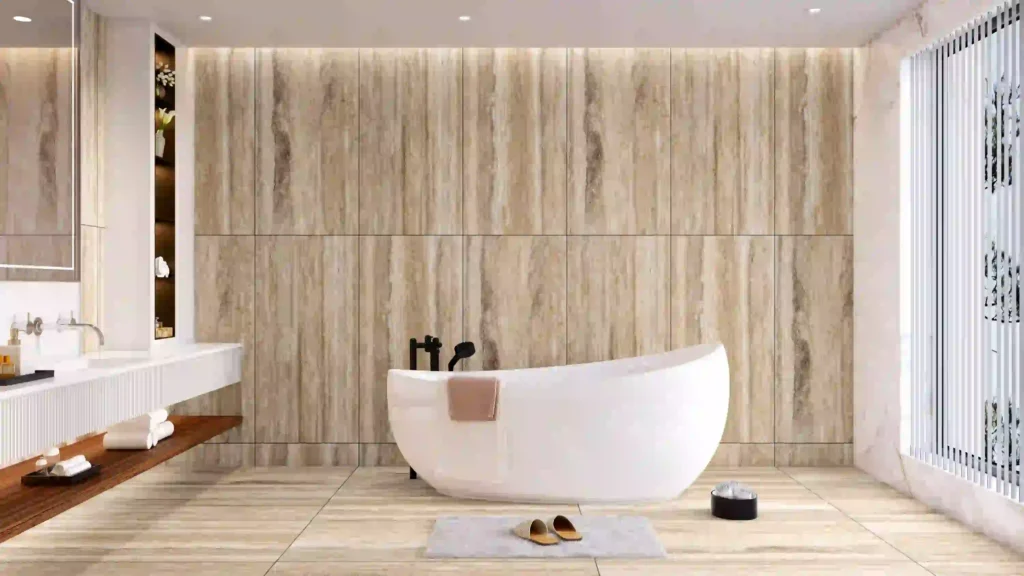Introduction:
When it comes to interior design, each component is vital in determining the overall look and feel of a room. Slab tiles are one of these components that has become well-known for being adaptable and transforming, with countless ways to improve the aesthetic appeal of interior spaces. Slab tile design has seen constant improvement over the years thanks to the efforts of manufacturers and designers, offering an amazing variety of textures, patterns, and finishes. This blog delves into the world of slab tiles and examines the most recent design advancements that are changing our understanding of and use for them in interior design.

Large Format Tiles:
The introduction of large-format tiles is one of the most notable developments in slab tile design. Tiles were previously only available in standard sizes, but advances in manufacturing technology have made it possible to produce tiles with far greater dimensions. By reducing grout lines, these large-format tiles—which can measure up to five feet in length and width—give interiors a seamless, modern appearance. They are particularly popular for flooring and wall applications in modern interiors, where a sense of expansiveness and continuity is desired.
Thin Porcelain Tiles:
Large thin porcelain panels, or LTPPs, are another name for thin porcelain tiles. They are a major advancement in slab tile technology. These incredibly thin tiles, which are usually 6 to 12 mm thick, have many benefits over conventional tiles. They are less expensive to handle and install because to their lightweight design, which also lessens their influence on the environment. LTPPs are extremely resilient and resistant to stains, scratches, and temperature changes despite having a thin profile. As a result, they can be used for a variety of purposes, including as exterior cladding, backsplashes, and worktops.
Textured Finishes:
Texture is essential for giving slab tiles depth and visual appeal. There is now a wide variety of textured surfaces that imitate natural materials like stone, wood, and concrete thanks to recent advancements in surface treatment processes. Designers may now utilize a wide range of textures, from rustic to contemporary, to create tactile experiences and eye-catching visual contrasts in a room. Slab tiles with texture are very well-liked for feature walls, fireplace surrounds, and accent walls since they may give the interior warmth and personality.
Textured Finishes:
Texture is essential for giving slab tiles depth and visual appeal. There is now a wide variety of textured surfaces that imitate natural materials like stone, wood, and concrete thanks to recent advancements in surface treatment processes. Designers may now utilize a wide range of textures, from rustic to contemporary, to create tactile experiences and eye-catching visual contrasts in a room. Slab tiles with texture are very well-liked for feature walls, fireplace surrounds, and accent walls since they may give the interior warmth and personality.
Slim Slab Technology:
In slab tile design, slim slab technology is the fusion of functionality and beauty. The lightweight qualities of thin porcelain combined with the advantages of large-format tiles make slim slabs an adaptable option for a variety of architectural and design applications. These incredibly thin tiles, which usually have a thickness of 3 to 6 mm, can be used to cover furniture, cabinetry, and counters to create a sleek and modern look. Additionally, slim slabs can be installed in a variety of ways because they can be laid directly over pre-existing surfaces, which saves demolition time and money on projects.
Environmental Sustainability:
Slab tile manufacturers have responded to the increased emphasis on environmental sustainability in the design and construction sector by creating eco-friendly substitutes for conventional materials. In order to reduce their carbon impact, many slab tiles are now made from recycled materials, such as used glass and porcelain, and they also use energy-efficient production techniques. Furthermore, the need for cutting endangered forests has decreased because to advancements in digital printing technology, which have allowed producers to produce tile designs that capture the natural beauty of exotic or endangered wood species.
Conclusion:
In summary, there has been constant innovation and experimentation in the development of slab tile design, yielding a wide variety of solutions that satisfy the changing requirements and tastes of both designers and homeowners. Slab tiles can be used in interior spaces in a plethora of ways, from large-format tiles to textured finishes and digital printing technology. We may anticipate even more fascinating advancements in the field of slab tile design in the years to come as technology keeps developing and sustainability gains more weight.




